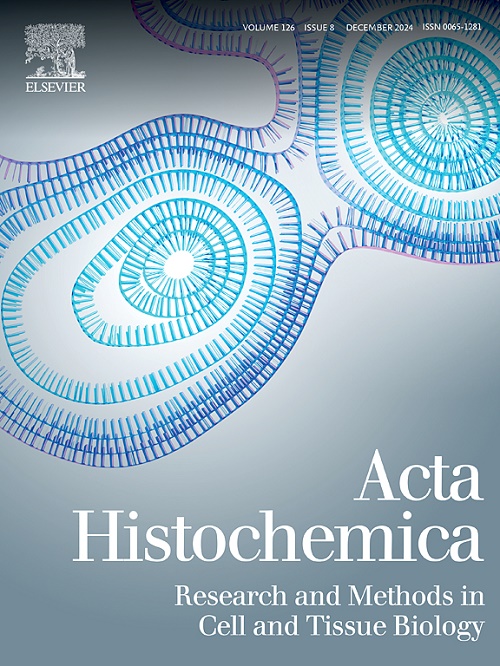Discovery of nuclear cavities in Epstein-Barr virus-infected cells
IF 2.4
4区 生物学
Q4 CELL BIOLOGY
引用次数: 0
Abstract
Approximately 90 % of humans are infected with the Epstein-Barr virus (EBV); however, most do not develop neoplastic lesions. Despite various investigations, the underlying reasons remain largely unknown. Therefore, we aimed to address this question through morphological observations to identify the ultrastructural alterations occurring in EBV-infected cells. EBV-positive cells from legacy lymph node specimens obtained from patients with HIV and modern fresh specimens of aberrantly proliferating human EBV-positive lymphocytes in a patient-derived xenograft (PDX) of immunodeficient mouse were examined. By utilizing a special technique that allowed us to observe exactly the same specimen using both optical and electron microscopy, we were able to detect a peculiar phenomenon in EBV-infected cells. EBV-infected lymphocytes occasionally exhibited nuclear cavities, a finding that was confirmed in multiple specimens from both patients with HIV and the PDX model. It was suggested that EBV-infected cells may activate cell death pathways, based on the protein expression patterns of p53 and FAS. Taken together, these results indicated that nuclear cavity formation appeared to be a characteristic morphological alteration associated with EBV infection. Further research could clarify the potential relationship between nuclear cavities and cellular biology in EBV-infected cells, possibly shedding light on the mechanisms that prevent EBV-infected cells from progressing to tumor formation.
在感染eb病毒的细胞中发现核空洞
大约90% %的人类感染了eb病毒(EBV);然而,大多数不会发展为肿瘤病变。尽管进行了各种调查,但潜在的原因在很大程度上仍然未知。因此,我们旨在通过形态学观察来解决这个问题,以确定ebv感染细胞中发生的超微结构改变。我们检测了HIV患者遗留淋巴结标本中的ebv阳性细胞和免疫缺陷小鼠患者源异种移植物(PDX)中异常增殖的人类ebv阳性淋巴细胞的现代新鲜标本。通过使用一种特殊的技术,使我们能够使用光学和电子显微镜观察完全相同的标本,我们能够在ebv感染的细胞中检测到一种特殊现象。ebv感染的淋巴细胞偶尔会表现出核空洞,这一发现在来自HIV患者和PDX模型的多个标本中得到证实。基于p53和FAS的蛋白表达模式,提示ebv感染的细胞可能激活细胞死亡途径。综上所述,这些结果表明,核腔的形成似乎是与EBV感染相关的特征性形态学改变。进一步的研究可能会澄清ebv感染细胞中的核空腔和细胞生物学之间的潜在关系,可能会揭示阻止ebv感染细胞进展为肿瘤形成的机制。
本文章由计算机程序翻译,如有差异,请以英文原文为准。
求助全文
约1分钟内获得全文
求助全文
来源期刊

Acta histochemica
生物-细胞生物学
CiteScore
4.60
自引率
4.00%
发文量
107
审稿时长
23 days
期刊介绍:
Acta histochemica, a journal of structural biochemistry of cells and tissues, publishes original research articles, short communications, reviews, letters to the editor, meeting reports and abstracts of meetings. The aim of the journal is to provide a forum for the cytochemical and histochemical research community in the life sciences, including cell biology, biotechnology, neurobiology, immunobiology, pathology, pharmacology, botany, zoology and environmental and toxicological research. The journal focuses on new developments in cytochemistry and histochemistry and their applications. Manuscripts reporting on studies of living cells and tissues are particularly welcome. Understanding the complexity of cells and tissues, i.e. their biocomplexity and biodiversity, is a major goal of the journal and reports on this topic are especially encouraged. Original research articles, short communications and reviews that report on new developments in cytochemistry and histochemistry are welcomed, especially when molecular biology is combined with the use of advanced microscopical techniques including image analysis and cytometry. Letters to the editor should comment or interpret previously published articles in the journal to trigger scientific discussions. Meeting reports are considered to be very important publications in the journal because they are excellent opportunities to present state-of-the-art overviews of fields in research where the developments are fast and hard to follow. Authors of meeting reports should consult the editors before writing a report. The editorial policy of the editors and the editorial board is rapid publication. Once a manuscript is received by one of the editors, an editorial decision about acceptance, revision or rejection will be taken within a month. It is the aim of the publishers to have a manuscript published within three months after the manuscript has been accepted
 求助内容:
求助内容: 应助结果提醒方式:
应助结果提醒方式:


